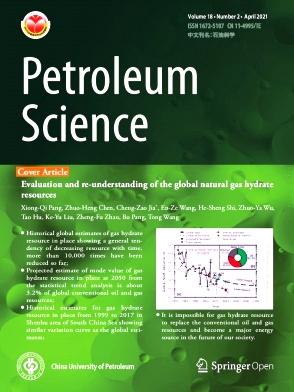Preparation of EVAM-g-NSiO2 nanocomposite pour point depressant and its effect on rheological properties of model waxy oil
IF 6
1区 工程技术
Q2 ENERGY & FUELS
引用次数: 0
Abstract
Modified ethylene-vinyl acetate copolymer (EVAM) and amino-functionalized nano-silica (NSiO2) particles were employed as the base materials for the synthesis of the nanocomposite pour point depressant designated as EVAM-g-NSiO2. This synthesis involved a chemical grafting process within a solution system, followed by a structural characterization. Moreover, combining macro-rheological performance with microscopic structure observation, the influence of the nanocomposite pour point depressant on the rheological properties of the model waxy oil system was investigated. The results indicate that when the mass ratio of NSiO2 to EVAM is 1:100, the prepared EVAM-g-NSiO2 nanocomposite pour point depressant exhibits excellent pour point reduction and viscosity reduction properties. Moreover, the nanocomposite pour point depressant obtained through a chemical grafting reaction demonstrates structural stability (the bonding between the polymer and nanoparticles is stable). The pour points of model waxy oils doped with 500 mg/kg ethylene-vinyl acetate copolymer (EVA), EVAM, and EVAM/SiO2 were reduced from 34 °C to 23, 20, and 21 °C, respectively. After adding the same dosage of EVAM-g-NSiO2 nanocomposite pour point depressant, the pour point of the model wax oil decreased to 12 °C and the viscosity at 32 °C decreased from 2399 to 2396.9 mPa ·s, achieving an impressive viscosity reduction rate of 99.9%. Its performance surpassed that of EVA, EVAM, and EVAM/SiO2. The EVAM-g-NSiO2 dispersed in the oil phase acts as the crystallization nucleus for wax crystals, resulting in a dense structure of wax crystals. The compact wax crystal blocks are difficult to overlap with each other, preventing the formation of a three-dimensional network structure, thereby improving the low-temperature flowability of the model waxy oil.

EVAM-g-NSiO2 纳米复合降凝剂的制备及其对模型蜡油流变特性的影响
采用改性乙烯-醋酸乙烯共聚物(EVAM)和氨基官能化纳米二氧化硅(NSiO)颗粒作为基础材料,合成了名为 EVAM-g-NSiO 的纳米复合降凝剂。合成过程包括在溶液体系中进行化学接枝,然后进行结构表征。此外,结合宏观流变性能和微观结构观察,研究了纳米复合降凝剂对模型蜡油体系流变特性的影响。结果表明,当 NSiO 与 EVAM 的质量比为 1:100 时,制备的 EVAM-g-NSiO 纳米复合降凝剂具有优异的降凝和降粘性能。此外,通过化学接枝反应获得的纳米复合降凝剂具有结构稳定性(聚合物与纳米颗粒之间的结合稳定)。掺杂了 500 mg/kg 乙烯-醋酸乙烯共聚物(EVA)、EVAM 和 EVAM/SiO 的模型蜡油的倾点分别从 34 ℃ 降至 23、20 和 21 ℃。添加相同剂量的 EVAM-g-NSiO 纳米复合材料降凝剂后,模型蜡油的倾点降至 12 °C,32 °C时的粘度从 2399 mPa -s 降至 2396.9 mPa -s,降粘率高达 99.9%。其性能超过了 EVA、EVAM 和 EVAM/SiO。分散在油相中的 EVAM-g-NSiO 可作为蜡晶体的结晶核,形成致密的蜡晶体结构。致密的蜡晶块很难相互重叠,无法形成三维网络结构,从而改善了模型蜡油的低温流动性。
本文章由计算机程序翻译,如有差异,请以英文原文为准。
求助全文
约1分钟内获得全文
求助全文
来源期刊

Petroleum Science
地学-地球化学与地球物理
CiteScore
7.70
自引率
16.10%
发文量
311
审稿时长
63 days
期刊介绍:
Petroleum Science is the only English journal in China on petroleum science and technology that is intended for professionals engaged in petroleum science research and technical applications all over the world, as well as the managerial personnel of oil companies. It covers petroleum geology, petroleum geophysics, petroleum engineering, petrochemistry & chemical engineering, petroleum mechanics, and economic management. It aims to introduce the latest results in oil industry research in China, promote cooperation in petroleum science research between China and the rest of the world, and build a bridge for scientific communication between China and the world.
文献相关原料
公司名称
产品信息
阿拉丁
3-Aminopropyltriethoxysilane (APTS)
阿拉丁
Maleic Anhydride (MAH)
阿拉丁
Methanol
阿拉丁
Toluene
阿拉丁
Azobisisobutyronitrile (AIBN)
阿拉丁
EVA
 求助内容:
求助内容: 应助结果提醒方式:
应助结果提醒方式:


